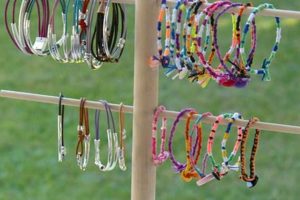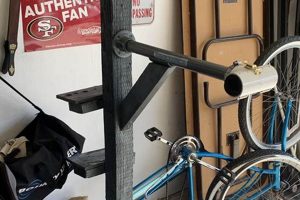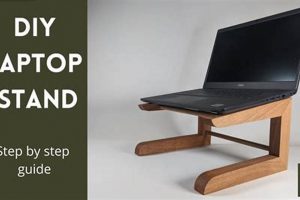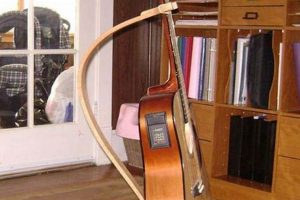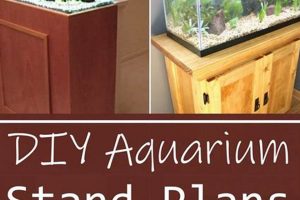A handcrafted support structure designed for equestrian equipment, particularly saddles, provides a personalized and often cost-effective solution for storage and maintenance. These self-constructed devices range from simple, utilitarian designs employing readily available materials to more elaborate and aesthetically pleasing pieces of functional art. Examples include stands fashioned from repurposed lumber, PVC piping, or even recycled metal, each tailored to accommodate specific saddle sizes and weights.
The utilization of such bespoke equipment preservation solutions offers multiple advantages. It facilitates proper ventilation, preventing mildew and leather damage. Furthermore, it contributes to organized tack rooms and stable environments, extending the longevity of valuable equestrian gear. Historically, equestrians have employed various methods of saddle support, evolving from rudimentary leaning posts to more sophisticated, purpose-built structures; the do-it-yourself approach represents a continuation of this tradition, leveraging modern materials and techniques.
The following sections will delve into the practical aspects of creating customized equipment supports, encompassing design considerations, material selection, construction techniques, and safety precautions. Subsequent discussions will also address customization options and tips for ensuring durability and aesthetic appeal of the finished product.
Essential Considerations for a Self-Made Saddle Support
The following guidelines are crucial for constructing a safe, functional, and durable support for equestrian saddles. Adherence to these principles will maximize the lifespan of both the support and the saddle it holds.
Tip 1: Material Selection: Prioritize durable, weather-resistant materials. Treated lumber, exterior-grade plywood, or powder-coated metal are suitable choices. Avoid untreated wood, which is susceptible to rot and insect infestation.
Tip 2: Structural Integrity: Ensure the base is sufficiently wide and stable to prevent tipping. A wider base distributes weight more effectively, particularly with heavier Western saddles.
Tip 3: Weight Capacity: Accurately estimate the maximum weight the support will bear. Over-engineering is preferable to under-engineering; reinforce joints and stress points accordingly.
Tip 4: Saddle Contact Points: Pad contact areas with felt, foam, or carpet to prevent abrasion and damage to the saddle’s leather or fabric. Secure padding firmly to prevent slippage.
Tip 5: Ergonomic Design: Design the support with a height that allows for comfortable saddle placement and removal. Consider the user’s height and the typical saddle storage location.
Tip 6: Weather Protection: If the support will be used outdoors, apply a weather-resistant sealant or paint to protect it from moisture and UV damage. Regular maintenance will prolong its lifespan.
Tip 7: Hardware Selection: Use corrosion-resistant hardware, such as stainless steel screws or bolts, to prevent rust and ensure structural integrity over time. Pre-drill holes to avoid splitting wood.
Implementing these construction practices enhances the safety, longevity, and usability of a handcrafted equestrian saddle support. Careful planning and execution are essential for a successful project.
The concluding sections will summarize the long-term benefits and potential enhancements to further improve a self-constructed saddle support.
1. Stability
Stability is a paramount concern in the design and construction of any support for equestrian saddles. The fundamental purpose of such a support is to securely hold the saddle, preventing it from falling and sustaining damage. Therefore, the inherent stability of a self-constructed saddle support directly impacts its functionality and the preservation of the equipment it holds. A poorly designed base, inadequate material strength, or improper weight distribution can lead to instability, resulting in the saddle tipping over. This exposes the saddle to potential damage from impact and abrasion against the ground or surrounding objects. Real-world examples demonstrate the consequences of insufficient stability, ranging from minor scuffs to significant tears in the saddle leather, necessitating costly repairs. The practical significance of understanding stability principles lies in the ability to proactively mitigate these risks through informed design choices.
Analyzing the factors contributing to stability involves several considerations. The base of the support must be sufficiently wide to create a low center of gravity. The materials utilized should be rigid and capable of withstanding the weight of the saddle without flexing or buckling. Joints and connections must be securely fastened to prevent movement or loosening over time. For instance, a design incorporating a wide, triangular base constructed from pressure-treated lumber, joined with heavy-duty screws and reinforced with metal brackets, would exhibit significantly greater stability than a narrow, lightweight structure assembled with insufficient fasteners. Furthermore, the distribution of weight is crucial; placing the saddle’s center of gravity directly over the base minimizes the risk of tipping.
In conclusion, the stability of a self-constructed saddle support is not merely a desirable feature but an essential prerequisite for its intended function. A lack of stability compromises the safety of the saddle and undermines the purpose of the support itself. By prioritizing stability in the design and construction phases, equestrians can ensure that their valuable equipment is securely and reliably stored, minimizing the risk of damage and maximizing the longevity of the saddle. This understanding serves as a cornerstone for successful crafting of practical equestrian saddle supports.
2. Material Strength
Material strength is a foundational element in the successful creation of a self-made saddle support. The capacity of the chosen materials to withstand the imposed load directly correlates with the structure’s ability to function as intended. Insufficient material strength leads to structural failure, potentially resulting in damage to the saddle and rendering the stand unusable. The cause-and-effect relationship is clear: inadequate material properties lead directly to compromised performance. The importance of selecting materials with appropriate strength characteristics cannot be overstated; it is a non-negotiable aspect of the design process.
Real-life examples illustrate the critical nature of this consideration. A stand constructed from thin, untreated lumber may buckle or collapse under the weight of a heavy Western saddle, while a similar design using reinforced steel or properly dimensioned, pressure-treated wood would provide adequate support. The practical significance lies in understanding the specific weight-bearing requirements of the intended saddle and selecting materials that demonstrably exceed those requirements. This understanding informs choices regarding wood species, metal gauge, and joining methods, ensuring the completed stand provides reliable and long-lasting service. Furthermore, considering environmental factors, such as humidity and temperature fluctuations, is essential. Materials susceptible to warping or decay will compromise the structural integrity of the entire support.
In summary, material strength is not merely a construction detail but a fundamental design parameter in the creation of a robust equestrian equipment support. Prioritizing the selection of materials with appropriate strength characteristics ensures the safety and longevity of both the stand and the saddle it holds. Overlooking this crucial element significantly increases the risk of structural failure, underscoring the need for careful consideration and informed decision-making throughout the construction process. It is the bedrock upon which a successful self-constructed saddle support is built.
3. Saddle Protection
Equestrian equipment, particularly saddles, represents a significant investment. The construction of a self-made support structure necessitates careful consideration of saddle protection to prevent damage and prolong the equipment’s lifespan. A well-designed self-assembled support mitigates risks associated with improper storage.
- Padding and Contact Points
Direct contact between the saddle and a hard surface can cause abrasion and indentation, particularly on delicate leather components. A self-constructed support must incorporate padding at all contact points. Felt, fleece, or closed-cell foam are suitable materials for this purpose. Padding should be securely affixed to the support to prevent slippage, ensuring consistent protection. Neglecting this facet can result in premature wear and diminished value of the saddle.
- Ventilation and Moisture Control
Confined storage environments can trap moisture, leading to mildew and leather rot. The design of the support should promote adequate ventilation around the saddle. Open frameworks or perforated surfaces facilitate airflow, preventing moisture accumulation. In humid climates, consideration should be given to incorporating moisture-absorbing materials, such as silica gel packets, within the storage area. Failure to address ventilation can result in irreversible damage to the saddle’s structural integrity.
- Shape and Support
The support structure should conform to the natural shape of the saddle, providing uniform support across its bearing surfaces. Improper support can lead to distortion of the tree and uneven pressure distribution, resulting in discomfort for the horse and potential damage to the saddle’s structure. Mimicking the contours of a horse’s back ensures that the saddle maintains its intended shape during storage. Simple A-frame designs or contoured supports are effective solutions.
- Dust and Debris Mitigation
Exposure to dust, dirt, and other environmental contaminants can degrade the quality of the saddle’s leather and fabric. While the construction of the support itself cannot eliminate dust, it should allow for easy cleaning and maintenance. Smooth, non-porous surfaces are preferable, as they minimize the accumulation of debris. The addition of a removable cover further protects the saddle from environmental contaminants. Regular cleaning of both the support and the saddle is essential for preserving its condition.
These protective measures, integrated into the creation of a self-made saddle support, contribute to the long-term preservation of equestrian equipment. Thoughtful design considerations safeguard the saddle from physical damage, environmental degradation, and structural distortion, thereby maximizing its useful life and maintaining its value.
4. Ergonomic Height
Ergonomic height is a crucial factor in the design and construction of self-made saddle supports. The appropriate height of the support directly influences user comfort, ease of access, and the prevention of physical strain during saddle handling. A carefully considered height minimizes the risk of injury and enhances the overall usability of the equipment.
- Reduced Back Strain
An ergonomically appropriate height minimizes the need for bending or lifting from a low position. This is particularly significant when handling heavy saddles, as repetitive bending can contribute to back strain and injury. The support should be positioned at a height that allows the user to maintain a neutral spine position while placing or removing the saddle. For example, a support designed for a taller individual would require a greater height than one intended for a shorter user. Designing for average heights and considering user customizability would be prudent.
- Improved Accessibility
A well-chosen height enhances the ease of accessing the saddle. It allows for a clear view of the saddle’s components and facilitates efficient cleaning and maintenance. When the support is too low, it restricts access, making it difficult to properly inspect and care for the saddle. Conversely, a support that is too high may require reaching, potentially leading to instability and accidental drops. Optimal accessibility contributes to safer and more efficient saddle management.
- Enhanced Safety
The ergonomic height reduces the risk of dropping the saddle during placement or removal. When the support is at a comfortable height, the user can maintain a secure grip on the saddle, minimizing the likelihood of accidents. Unnecessary lifting and reaching, often associated with improperly designed supports, increase the risk of losing control of the saddle. A stable and appropriately sized support, combined with an ergonomic height, enhances overall safety in the tack room or stable environment.
- Adaptability to User Needs
While a fixed-height design may be suitable for some users, adjustable-height supports offer greater versatility. Adjustable designs allow the user to customize the height to their specific needs, accommodating variations in stature and saddle size. This adaptability is particularly valuable in shared tack rooms, where multiple users with varying heights may utilize the same support. Mechanisms such as telescoping legs or adjustable shelving can provide a range of height options, ensuring optimal ergonomic positioning for all users.
In conclusion, ergonomic height is not a trivial consideration but an essential design element in creating a functional and user-friendly support for equestrian saddles. By prioritizing ergonomic principles, individuals can minimize the risk of injury, improve accessibility, and enhance the overall safety and efficiency of saddle management. The integration of adjustable features further increases the value and adaptability of self-made supports, making them suitable for a wider range of users and environments. It is also worthy to note that a comfortable design promotes the longevity and care of equestrian equipment through its simplicity in design.
5. Weather resistance
Weather resistance is a critical consideration in the design and construction of self-made saddle supports intended for outdoor or semi-enclosed environments. Exposure to the elements, including rain, sunlight, and temperature fluctuations, can significantly degrade the structural integrity and protective capabilities of a poorly constructed support. The selection of appropriate materials and finishes directly impacts the longevity and functionality of the stand. For example, untreated lumber will rapidly deteriorate when exposed to moisture, leading to rot, warping, and eventual collapse. The consequence is not only the loss of the support itself but also potential damage to the saddle it is intended to protect. Real-world instances include supports fabricated from untreated pine collapsing after a single season of outdoor use, underscoring the practical significance of weather-resistant design principles.
Effective strategies for enhancing weather resistance include the use of pressure-treated lumber, which is chemically treated to resist decay and insect infestation. Alternatively, naturally durable wood species, such as cedar or redwood, offer inherent resistance to the elements. In addition to material selection, the application of protective coatings is essential. Exterior-grade paints, stains, and sealants provide a barrier against moisture penetration and UV damage. Regular maintenance, including periodic reapplication of coatings, further extends the lifespan of the support. Metal components, if used, should be corrosion-resistant, such as stainless steel or powder-coated steel, to prevent rust and maintain structural integrity. The specific climate and expected exposure conditions should inform the selection of materials and protective measures. A support intended for year-round outdoor use in a wet climate requires a higher level of protection than one used seasonally under a covered shelter.
In summary, weather resistance is not merely a desirable feature but a necessity for self-made saddle supports destined for outdoor or semi-enclosed environments. The careful selection of materials, the application of protective coatings, and regular maintenance are essential for ensuring the longevity, structural integrity, and protective capabilities of the support. Neglecting weather resistance leads to premature failure and potential damage to valuable equestrian equipment. Prioritizing weather-resistant design principles is a prudent investment in the long-term functionality of the support. As a key component of any outdoor design, it needs to be taken into account for any do-it-yourself project.
6. Weight capacity
Weight capacity is a fundamental engineering consideration in the construction of a self-made saddle support. It represents the maximum load the structure can bear without experiencing structural failure or deformation. The relationship between this parameter and the intended function of the support is direct: if the weight of the saddle exceeds the support’s capacity, the structure is at risk of collapse. This compromises the safety of the saddle and potentially causes damage to the surrounding environment. Therefore, an accurate assessment of the saddle’s weight and a conservative estimation of the support’s load-bearing capability are essential. Real-world examples demonstrate the consequences of neglecting this principle, with instances of DIY supports constructed from insufficiently strong materials collapsing under the weight of heavy Western saddles. The practical significance lies in recognizing weight capacity as a critical design constraint, driving material selection and structural design decisions.
The determination of weight capacity involves several factors, including the type of materials used, the dimensions of structural members, and the methods of joining components. For instance, a support constructed from pressure-treated lumber with robust joints will possess a higher weight capacity than one built from thin, untreated wood with simple screw connections. Engineering principles can be applied to calculate the load-bearing capacity of individual components and the overall structure. Online resources and structural calculators provide tools for estimating the weight capacity of wood and metal beams. A conservative approach is recommended, incorporating a safety factor to account for uncertainties in material properties and load distribution. This may involve selecting materials that are stronger than theoretically necessary or reinforcing critical joints with additional hardware.
In summary, weight capacity is a non-negotiable aspect of DIY saddle support design. It is a direct determinant of the structure’s ability to safely and reliably perform its intended function. An accurate assessment of the saddle’s weight, coupled with a conservative estimation of the support’s load-bearing capability, is paramount. Neglecting this consideration leads to a high risk of structural failure, potentially damaging the saddle and posing a safety hazard. Prioritizing weight capacity as a key design constraint ensures the creation of a functional and durable support that meets the needs of the equestrian environment.
7. Cost effectiveness
The pursuit of a self-made saddle support is often driven by considerations of cost effectiveness, where the potential for economic savings motivates the do-it-yourself approach. Purchasing a commercially manufactured saddle stand can represent a significant expense, particularly for equestrians with multiple saddles or limited budgets. Constructing a saddle support using readily available or repurposed materials presents an opportunity to reduce costs substantially. However, a superficial focus on initial cost savings can be detrimental if it leads to compromises in structural integrity or durability. A poorly constructed support that fails prematurely or damages the saddle ultimately proves to be less cost effective than a more robust, commercially available alternative. Therefore, a holistic view of cost effectiveness necessitates considering not only the initial investment but also the long-term durability and potential for damage mitigation.
Real-world examples illustrate the dichotomy between short-term savings and long-term value. A support built from reclaimed lumber and basic hardware might initially appear to be a cost-effective solution. However, if the lumber is not properly treated or the joints are inadequately secured, the support may deteriorate rapidly or collapse under the weight of the saddle, resulting in the need for repairs or replacement. Furthermore, sharp edges or inadequate padding can cause abrasion to the saddle leather, necessitating costly repairs or even replacement of the saddle. Conversely, a self-made support constructed from higher-quality materials, such as pressure-treated lumber or steel, and assembled with robust hardware, represents a greater initial investment but offers superior durability and protection, ultimately proving more cost effective over the long term. The practical significance lies in adopting a balanced approach, prioritizing both economic savings and long-term value.
In summary, cost effectiveness is a legitimate and often compelling motivation for constructing a self-made saddle support. However, a myopic focus on minimizing initial costs can lead to compromises in structural integrity, durability, and saddle protection, ultimately undermining the intended economic benefits. A balanced approach that considers both the initial investment and the long-term value, including durability, protection, and potential repair costs, is essential for achieving true cost effectiveness. The careful selection of materials, the application of sound construction techniques, and a holistic assessment of long-term costs are crucial for realizing the economic advantages of a self-made saddle support without sacrificing quality or functionality.
Frequently Asked Questions
The following questions address common inquiries regarding the creation and utilization of supports for equestrian saddles.
Question 1: What are the primary advantages of constructing a equipment support versus purchasing a commercially manufactured one?
The principal advantage lies in customization. A self-constructed support can be tailored to specific saddle dimensions, storage space constraints, and individual ergonomic preferences. Furthermore, a DIY approach can offer cost savings, particularly when utilizing reclaimed or readily available materials.
Question 2: What materials are best suited for constructing a robust and durable equipment support?
Pressure-treated lumber, exterior-grade plywood, and steel are all suitable materials for constructing a durable support. The selection should be based on the intended use environment, the weight of the saddle, and the desired aesthetic appearance.
Question 3: How can saddle supports be designed to prevent damage to the saddle’s leather or fabric?
Padding all contact points with felt, fleece, or closed-cell foam is crucial. The support structure should also conform to the natural shape of the saddle to prevent distortion or uneven pressure distribution. Proper ventilation is essential to prevent moisture buildup and mildew growth.
Question 4: What safety precautions should be observed during the construction process?
Appropriate personal protective equipment, including eye protection and gloves, should be worn at all times. Power tools should be used in accordance with manufacturer’s instructions. Ensure a stable and well-lit work environment. All connections should be securely fastened to prevent structural failure.
Question 5: How can I ensure adequate stability of self-made equipment support?
A wide base, low center of gravity, and robust construction are essential for stability. The support should be tested under load before placing the saddle on it. Reinforce joints and connections as needed to prevent tipping or wobbling.
Question 6: How can I extend the lifespan of the saddle support, particularly if it is used outdoors?
Apply a weather-resistant sealant or paint to protect the wood from moisture and UV damage. Regularly inspect the support for signs of wear or damage and make repairs as needed. Store the support under cover during periods of prolonged inclement weather.
Careful planning, material selection, and construction techniques are essential for creating a safe, functional, and durable support for equestrian saddles. Prioritizing these aspects will maximize the lifespan of both the support and the saddle it holds.
The concluding section will summarize the long-term benefits and potential enhancements to further improve self-constructed supports for equestrian equipment.
DIY Saddle Stand
The preceding analysis has detailed the multifaceted considerations involved in the creation of a self-constructed equipment support. From material selection and structural integrity to ergonomic design and weather resistance, the construction process demands a rigorous approach. The economic benefits of a “diy saddle stand” are contingent upon a comprehensive understanding of engineering principles and a commitment to employing appropriate construction techniques. Neglecting these critical factors can result in a structure that compromises the safety and preservation of valuable equestrian equipment.
The long-term efficacy of a “diy saddle stand” extends beyond mere economic savings. It represents a commitment to resourcefulness, customization, and a deeper understanding of equestrian equipment care. A well-executed project reflects a dedication to craftsmanship and a proactive approach to preserving the tools of the equestrian pursuit. The future of “diy saddle stand” design lies in innovative material selection, sustainable practices, and the integration of user-centric ergonomic principles, ultimately fostering a community of informed and skilled equestrians.


